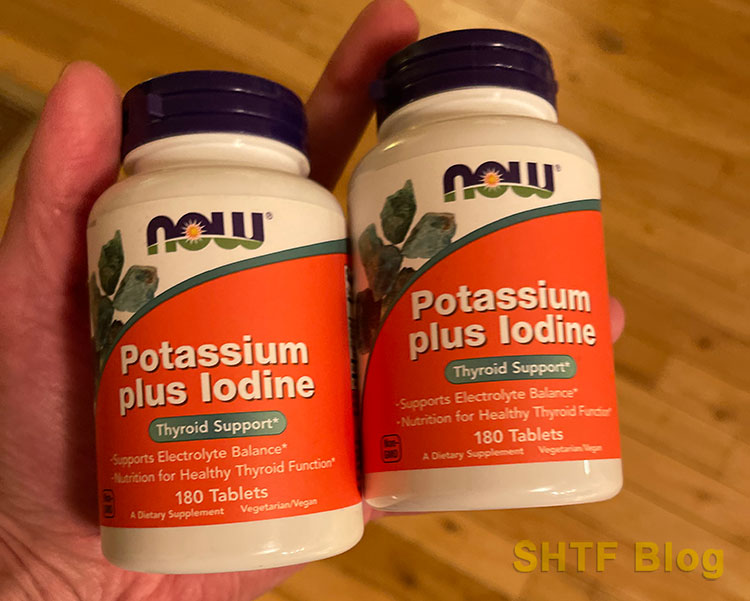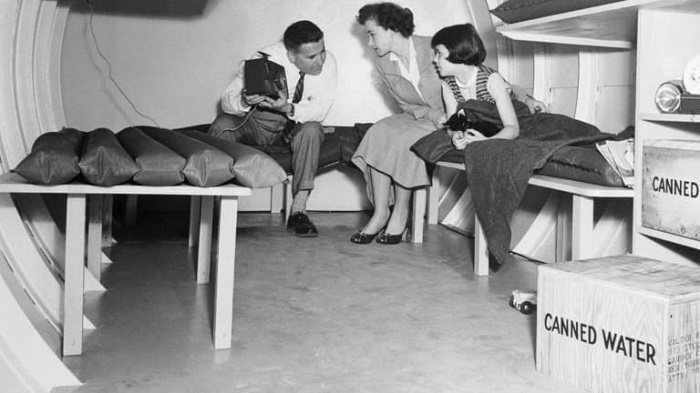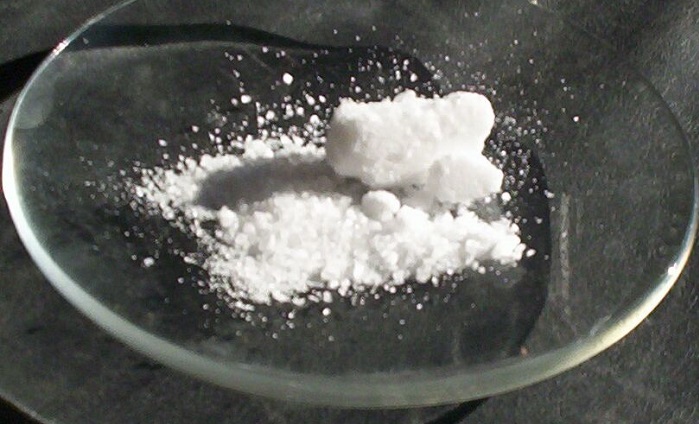
There can be a lot of confusion when it comes to what to do post-nuclear attack. Odds are that you may have heard that taking potassium iodide can help, but maybe that’s the limit of your knowledge. How does it help? When do you take it? Who should take it? Let’s take a closer look…
The Dangers of Exposure to Nuclear Fallout
Immediately following a nuclear attack/accident there will be large amounts of radioactive material shot up into the sky. This material will be visible dirt and debris, and it is known as nuclear fallout. Nuclear fallout will eventually fall back down to the earth (from a height of several miles), irradiating the area where it is present. It can cause sickness and death to those who are exposed to it, and so it is absolutely vital that you avoid fallout as much as possible, particularly in the first few hours post-detonation, as this is when fallout is most dangerous (due to the higher levels of radiation).1
Exposure to fallout can result in acute radiation sickness, also known as ARS, and the symptoms can manifest themselves minutes to days after the initial exposure. So, sometimes you may not be 100% sure whether you’ve been poisoned by radiation or not.2
Every prepper should know how to make an expedient fallout shelter in their home. Look at our free downloadable fallout shelter designs and print them off – just in case.
The initial blast will shoot the radiation high enough into the atmosphere that, if you’ve not been incinerated by the fireball or liquefied by the percussive blast, you theoretically could have up to fifteen minutes before the fallout falls back to earth. That fifteen minutes could very well be enough time to take a few simple steps to stay safe.

Immediate steps to mitigate radioactive exposure should include:
- seeking out the basement or interior of a building (to protect yourself from most skin contact and inhalation dangers;
- removing your clothing and washing off the skin to get radioactive particles off of you;
- staying inside for at least 24 hours post-blast.1
However, if you can stay inside longer, by all means do so. Radioactive fallout decays very rapidly, but the longer that you can stay away from it, the better off you’ll be. By waiting 48 hours, the exposure rate would drop down to 1% for a hypothetical 10 Kt blast.3
For more information, consider reading U.S. Armed Forces Nuclear, Biological And Chemical Survival Manual by Dick Couch.
- Couch, Dick (Author)
- English (Publication Language)
- 256 Pages - 04/03/2003 (Publication Date) - Basic Books (Publisher)
The Role of Potassium Iodide (Iodine)

Potassium iodide – also known as KI – works by protecting the organ that is most vulnerable to radiation damage – the thyroid. The thyroid likes to absorb iodine, but it can’t differentiate between radioactive and stable iodine. As a result, it will readily absorb either. KI works by flooding the thyroid to the point that it can’t absorb anymore with stable iodine for 24 hours, so that the radioactive iodine won’t be absorbed instead.4
Here are a few options for buying and storing Potassium Iodide:
- 30 mg PER TABLET: This supplement is Non-GMO Project Verified
- FOR SHORT-TERM USE: As directed by a healthcare practitioner for single day short-term use only: Adults and adolescents 3 tablets; Children ages 4-12 years 2 tablets; Children ages 1-3 years 1 tablet
- CLASSIFICATIONS/CERTIFICATIONS: Vegan, Soy Free, Non-GMO Project Verified, Kosher
- GMP Quality Assured: NPA A-rated GMP certification means that every aspect of the NOW manufacturing process has been examined, including our laboratory/testing methods (for stability, potency, and product formulation)
- Packaged in the USA by a family owned and operated company since 1968
- IOSAT - Pack of 3
KI does NOT keep radioactive iodine from entering the body, CANNOT reverse damage to the thyroid that has already occurred, does NOT protect the body from other forms of radiation. Further, it does NOT protect any other part of the body other than the thyroid gland.4
It’s important to note that other sources of iodine, such as in food or vitamins, do NOT contain high enough levels of the salt in order to protect the thyroid against radiation poisoning.4 Using these as substitutes for proper KI can have deadly consequences.
When Should You Take KI?
There are a number of potentially grave health risks that are associated with KI consumption. Thus, it’s important that one does not ingest KI willy nilly. The CDC states that KI should only be taken when recommended to do so by public health or emergency management officials state that it is wise to do so.5
This helps one to further understand the importance of being properly prepared for disaster. Without having proper communications equipment available, you may not have any idea whether there was a nuclear blast within your vicinity or not.
Should the power suddenly go out in your region due to a blast hundreds of miles away, you may not know that there’s a fallout shower heading your way unless you have a proper working radio.
Battery operated and hand crank radios will still function after a nuclear detonation according to ready.gov. Cellphones, internet, and TV will most likely not work.1 The ability to achieve proper intelligence is vital to survival. Information helps you to make better choices.
Potassium Iodide is important to stock if you think there is a chance of a large nuclear exchange or if you live near a nuclear power plant. The New York State Department of Health has offered advice on KI specifically for the latter.
Side Effects and Adverse Health Effects of KI
It’s very easy to think “well, if a little is good, then a lot is better!”, but this is most certainly not the case with KI. There are potential adverse health effects to KI ingestion that one needs to be aware of. Taking too much KI can lead to severe injury, illness, or even death. Gastrointestinal upset, allergic responses, rashes, and salivary gland inflammation are all potential side effects, as are rare thyroid gland issues.4
If an infant ingests more than the recommended dosage of KI, they can end up developing hypothyroidism, which can lead to brain damage. Infants can also experience other problems with normal development as they grow.4
Considerations for Special Populations
During a nuclear disaster, babies in the womb, infants, young children, and people with low levels of iodine in their thyroids are going to be at the greatest risk of radiation-related thyroid damage. Infants in particular are at the highest risk of thyroid damage due to absorption of radioactive iodine.4 Considering that the young of any life form on the planet are most susceptible to harmful biological agents and environmental contaminants, this makes sense. The young are virtually always vulnerable.
As a result, the Food and Drug Administration (FDA) recommends that all children who are likely contaminated with radioactive iodine take KI UNLESS they have known allergies to KI. Young adults are less likely to experience the negative side effects of KI ingestion when compared to children and newborns, however.
All forms of radiation can cross the placenta, and so pregnant mothers who have been exposed to radioactive iodine are recommended to take a single dose of KI in order to protect both them and the baby that’s growing inside the womb. Likewise, breastfeeding mothers should only take a single dose if they believe that they have been contaminated.4
Adults who are over the age of 40 should NOT take KI unless directed to do so by emergency management or public health officials. That is an age group most likely to experience deleterious side effects from KI ingestion. They are also the age group that is least likely to suffer from radiation caused damage to their thyroid gland as well.4
Iodine Dosage Information
The following information is quoted directly from the CDC website.
According to the FDA, the following doses are appropriate to take after internal contamination with (or likely internal contamination with) radioactive iodine:
- Newborns from birth to 1 month of age should be given 16 mg (¼ of a 65 mg tablet or ¼ mL of solution). This dose is for both nursing and non-nursing newborn infants.
- Infants and children between 1 month and 3 years of age should take 32 mg (½ of a 65 mg tablet OR ½ mL of solution). This dose is for both nursing and non-nursing infants and children.
- Children between 3 and 18 years of age should take 65 mg (one 65 mg tablet OR 1 mL of solution). Children who are adult size (greater than or equal to 150 pounds) should take the full adult dose, regardless of their age.
- Adults should take 130 mg (one 130 mg tablet OR two 65 mg tablets OR two mL of solution).
- Women who are breastfeeding should take the adult dose of 130 mg.”4 The FDA has approved both tablet and liquid forms of KI to be taken orally. The tablets come in 130mg and 65mg doses, and have lines on them to make them easier to cut (for smaller doses). The liquid contains 65mg of KI per mL.4
How Long Does Iodine Store?
According to the US Nuclear Regulatory Commission (NRC), the 130mg tablet that they distribute has a shelf life of seven years, while the 65mg tablet has a shelf life of six years. The liquid formulation has a shelf life of five years. However, the NRC also points out that KI is an inherently stable compound, and does NOT lose effectiveness over time. The point of the date is to adhere to regulations that mandate particular products have a listed shelf life in order to protect consumer safety.
Several studies over the past several years have shown that KI does not undergo any significant amount of chemical degradation with the course of time. Some older specimens did show a longer dissolution time, but it was noted that this could be overcome by crushing the tablets into a powder and mixing them in a liquid such as juice in order to speed up the absorption rate.6
Other Items to Consider
If you want to take your preparations for radioactive fallout further, consider adding the following items to your supplies:
- NukAlert Nuclear Radiation Detector. Carried everywhere your keys go, NukAlert is monitoring for radiation 24/7 and it will alert you if you are being exposed to dangerous levels of radiation.
- 3M Pro Strength Industrial Duct Tape. Perfect for sealing off doors and windows in the event of radioactive fallout.
- Esky Portlable Emergency Weather Radio (Hand Crank and Self Powered. A must for emergencies. No need to rely on electricity or batteries. It can be charged by the hand crank, through micro USB charging, or by solar.
Wrapping Iodine and Nuclear Fallout Up
When it comes to prepping, even if you don’t really believe that the risk of nuclear attack/accident is something to worry about, I don’t see why one would not invest a few dollars in potassium iodide tablets.
They’re inexpensive, relatively easy to find, and don’t take up much space. In the event that you ARE exposed to dangerous radiation, they very well could help save your life.
Article References
- https://www.ready.gov/nuclear-explosion
- https://www.cdc.gov/nceh/radiation/emergencies/symptoms.htm
- https://www.remm.nlm.gov/nuclearexplosion.htm
- https://www.cdc.gov/nceh/radiation/emergencies/ki.htm
- https://www.cdc.gov/nceh/radiation/emergencies/emergencyfaq.htm#31
- https://www.nrc.gov/about-nrc/emerg-preparedness/about-emerg-preparedness/potassium-iodide/ki-faq.html
Note: I am NOT a doctor. This post is most certainly NOT me giving medical advice either. I do have a Master’s in Public Health, where I studied bioterrorism, dirty bombs, epidemiology, and the like, but I DO NOT give out medical advice. Instead, what I’m going to do here is to take a look at what the government has to say about iodine and nuclear fallout.




7 comments
Nice and concise. How about pets? Painting a strip of liquid iodine on their belly? Would that help?
Great question! I found this: https://www.mbah.ms.gov/emergency_programs/ki_vets.htm
Thanks. I also found a small piece from Doc Joe Alton: https://www.doomandbloom.net/radiation-sickness-2/ … I could have sworn someone said to paint a stripe of iodine on your pet’s belly.
Great article! Very informative on several levels. I only have one concern. Up until now, many of us have believed the CDC and FDA to be corrupt entities that lie through their teeth. Now we’re supposed to believe them about dosing? I know the dosages you gave have been in place for many years, not just recently, but I’d love to know if the doses are based on REAL studies, not like the non-existent studies for vaccines.
Also, If we get nuked, would that not also take out all radio communication? How would the govt be able to communicate with the people near or outside of Ground Zero? I understand crank and battery operated devices will work, but my question is will the radio stations be able to transmit?
Getting nuked may/may not take out radio communication. It really depends on where the point of impact was, how far radio towers are from it, how extensive a nuclear exchange was, etc. A couple nukes does not mean the end of the world. I full scale, multinational exchange – that might do it for most of us. I think what you might be thinking of is more along the lines of an EMP, which is similar, but not the same as a ground hit.
Apple Fruit Pectin – Has a highly absorptive quality that draws numerous harmful substances out of your intestines, especially heavy metals like mercury and lead. It even draws carcinogenic radioactive materials like strontium 90 (it was used at Chernobyl to draw radioactive particles from the people there).
Another proven way in which apples reduce the risk of cancer is through their ability to remove carcinogenic radioisotopes that have accumulated in our bodies as a result of the fallout from nuclear weapons, depleted uranium munitions, and nuclear energy and disaster-associated pollution, e.g. Chernobyl and Fukushima.
Post-Chernobyl, for instance, apple pectin was used to reduce Cesium-137 levels in exposed children, in some cases by over 60%. From 1996 to 2007, a total of more than 160,000 “Chernobyl” children received pectin food additives. As a result, levels of Cs-137 in children’s organs decreased after each course of pectin additives by an average of 30-40%. Significant reductions were noted in as short a time period as 16 days. Apple pectin has even been found to prevent the most deadly, and entirely man-made radioisotope, Plutonium-239, from absorbing in the gastrointestinal tract of animals fed it.
We could, therefore, modernize our apple aphorism by saying “an apple a day keeps the nuclear fallout away.” And truly, there are very few other substances, natural or synthetic, that have ever been found to protect against plutonium exposure. Apples, therefore, are truly super-foods in this respect.
Seaweed Soup “Miso” for Radiation Poisoning/Cancer – Traditionally, miso soup begins with a broth called “dashi,” made by soaking seaweed such as kombu in water and cooking with bonito flakes (flakes of dried fermented fish).
The late Dr. Akizuki, a medical doctor in Nagasaki at the time of the atomic bombing, survived and served to help the injured. He observed that these survivors had a common diet practice, which was a traditional Japanese diet enriched with Miso. Dr. Akizuki unfortunately passed away in 2005, but I was able to interview Mrs. Akizuki, as well as other atomic bomb survivors, a total of 30 people, in Hiroshima and Nagasaki, while I was in Japan in the summer of 2006. Utilizing the interview data, this study will examine atomic bomb survivors’ dietary history for the purpose of qualitatively discussing the relationship between traditional Japanese food enriched with Miso and their health conditions after exposure to the atomic bomb. The atomic bombs were tragic events, but we can turn them into valuable lessons that can improve our health and eventually help us find ways to prevent and / or control cancer. My hope is that this study may shed light on the importance of diet to the human body’s physical well-being, as well as applying it to today’s medicine.
If you want to read more about this (see website https://www.yufoundation.org/pdfs/furo.pdf)
If you want to make SSKI Saturated Liquid Solution, here is how you can make it. I bought 100 grams pharma grade potassium iodide, and divided it over 10 dropper vials of 10ml. 9 of these will find their way to selected people, for their families. When push comes to shove, 7ml water is added to each vial, resulting in saturated KI, 2 drops of which is an adult, 1 drop child, ½ drop for infant daily dose of emergency iodide for 10 days. 80 doses to a vial, the vial with content cost me less than $3 instead of $90 for pills, and it has an infinite shelf life, just don’t add water til needed. Feel free to spread this “recipe” to any survival communities you are a member of.